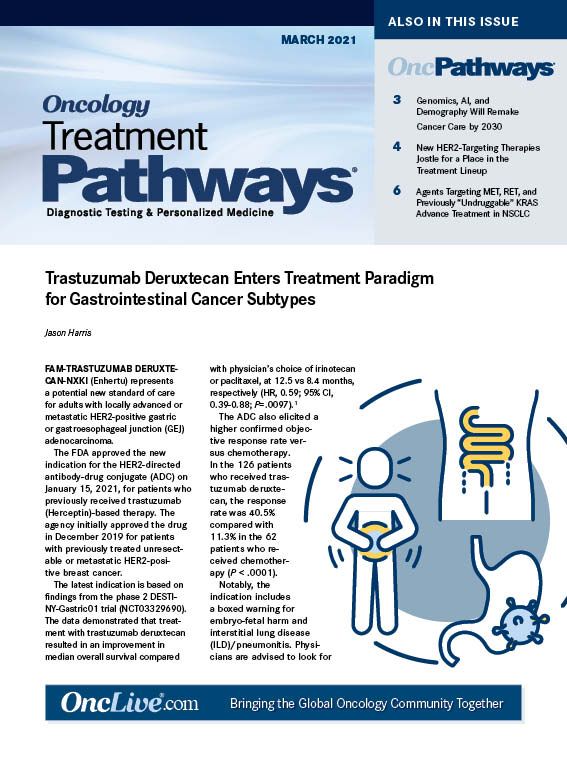Publication
Article
Oncology Treatment Pathways®
Agents Targeting MET, RET, and Previously “Undruggable” KRAS Advance Treatment in NSCLC
Author(s):
Melissa L. Johnson, MD, discusses the implications of recent advances made in the development of oncogenetargeted agents in non–small cell lung cancer.
Melissa L. Johnson, MD

Approximately 40% of patients with lung cancer harbor genetic abnormalities, said Melissa L. Johnson, MD, who stressed that next-generation sequencing (NGS) must be performed to ensure that patients are being matched with the correct targeted therapy.
In February 2021, the FDA granted an accelerated approval to tepotinib (Tepmetko) for use in patients with metastatic non–small cell lung cancer (NSCLC) harboring MET exon 14 skipping alterations.1 The regulatory decision was based on data from in the phase 2 VISION trial (NCT02864992), which showed that the MET inhibitor induced an objective response rate (ORR) of 43%.2
In May 2020, the FDA gave the green light to capmatinib (Tabrecta) for use in patients with metastatic MET exon 14 skipping–mutated NSCLC based on data from the phase 2 GEOMETRY mono-1 study (NCT02414139), which showed that the agent elicited an ORR of 67.9%.3 In the same month, selpercatinib (LOXO-292; Retevmo) also received regulatory approval from the FDA for use in patients with RET alteration–positive NSCLC, after the agent induced an ORR of 64%.4 The FDA approval of pralsetinib (Gavreto) followed close behind, in September 2020, when it was indicated for patients with RET fusion-positive NSCLC after having elicited an ORR of 57%.4,5
Although several therapies have been developed to target these oncogenic drivers, there has been a dearth of KRAS-targeted therapies; this changed with the emergence of agents like sotorasib (formerly AMG 510) and adagrasib (MRTX849).
“KRAS has been very difficult to target for 30 years. Some of the problem is that KRAS cycles between guanosine triphosphate on and guanosine diphosphate [GDP] off, so it’s not in the same state all the time. Both KRAS G12C inhibitors [that have been developed] lock KRAS in its GDP-bound off state,” explained Johnson. “It was the discovery of this solvent II binding pocket that is visible or accessible when the KRAS protein is in its GDP-bound off state that allowed these drugs to be developed. It’s a cool story, and I’m watching the development of drugs in this space absolutely with interest.”
In an interview With OncLive® during a 2020 Institutional Perspective in Cancer webinar on Lung Cancer, Johnson, an associate director of lung cancer research at Sarah Cannon Research Institute, discussed the implications of recent advances made in the development of oncogenetargeted agents in NSCLC.
OncLive®: Which targeted agents have been recently added to the National Comprehensive Cancer Network (NCCN) guidelines in NSCLC?
For these oncogenic drivers, KRAS does not yet have an FDA-approved indication. We have known about KRAS mutations for more than 30 years and how relevant they are in the development of lung cancers, but they have been very hard to treat. That being said, 2 drugs with encouraging clinical trial data [read out] in 2020: sotorasib, a direct KRAS G12C inhibitor made by Amgen, and adagrasib, a direct KRAS G12C inhibitor made by Mirati. I would anticipate that we would see the approvals of these drugs in years to come, and then they’ll be added to the NCCN guidelines.
[Regarding] MET alterations, [a patient] can have MET exon 14 [METex14] skipping alterations or amplification of MET gene copy number. A high gene copy number—6 or higher per cell—is what we consider therapeutically relevant. Crizotinib [Xalkori] was [granted a breakthrough therapy designation] for patients with MET [exon 14 alterations]. Just [last] year, capmatinib was added to the NCCN guidelines after it was FDA approved for [use] in patients with METex14 skipping mutations, as well as in those with a MET gene copy number higher than 10.
Tepotinib is another MET tyrosine kinase inhibitor [TKI] [that has emerged in the paradigm]; it is not yet approved but received a breakthrough therapy designation from the FDA. I would anticipate, likewise, that this TKI will be added to the NCCN guidelines [in the near future].
Finally, the 2 drugs selpercatinib [Retevmo] and pralsetinib [Gavreto] were [FDA] approved for patients with RET fusion–positive lung cancer and so were both added to the NCCN guidelines.
What were some of the lessons learned from the GEOMETRY mono-1 and VISION studies with regard to NGS?
[These studies produced] the positive results we saw with capmatinib and tepotinib, respectively. First, the GEOMETRY study looked at patients with either METex14 skipping mutations or MET elevated gene copy number. Various cohorts were examined; they included patients with gene copy number 4 to 6, 6 to 10, and 10 and higher. One of the take-home lessons from this study was that although we would expect patients with METex14 skipping mutations to respond to these MET-directed TKIs, patients with high levels of gene copy number also responded.
It’s really important to look at the NGS report and know that it’s not just a couple of copy numbers of MET that are sufficient for [patients] to be treated with capmatinib but, rather, more than 10. That’s an important distinction that I don’t believe we’ve spoken about in lung cancer before; it’s something we have discussed in breast cancer with HER2 overexpression versus gene copy number.
The VISION study [NCT02864992] evaluated tepotinib in that same group of patients with MET alterations. Here, the interesting take-home lesson was that MET alterations were found by analyzing tissue or blood; it didn’t matter which medium was used. The response rate when [patients were] treated with tepotinib was in the 40% to 50% range. This seems to be another alteration you can find in the plasma if you don’t have adequate tissue to do your NGS.
If tepotinib is approved down the line, what factors do you consider when choosing an agent for your patients with MET alterations?
We have used crizotinib in the past because it was the only show in town. We know that it targets not just MET; it is also an ALK and a ROS1 inhibitor. I do believe that both capmatinib and tepotinib are more potent MET inhibitors, so [if] tepotinib is approved, I will likely choose that or capmatinib over crizotinib. All the MET-directed therapies have a similar adverse effect [AE] profile in terms of edema, weight gain, nausea, and diarrhea. Beyond that, picking one and learning to use it is probably what I will do.
Shifting to developments made with RET-targeted treatments, what are some of the key players that have changed care for these patients?
These are some of my favorite drugs. Where I practice in Tennessee, we see a lot of RET fusions—maybe more than we see EGFR or ALK, which is interesting. We’ve used selpercatinib in clinical trials for a while. Both this drug and pralsetinib are great in that they are highly potent for RET translocation. Patients feel really well and the AE profile is quite mild. Some hypertension [is reported], as well as a little bit of edema, but both are very well-tolerated drugs.
In the most recent months, we have also started to hear about how selpercatinib appears to have good intracranial penetration; this is a relevant end point for all of our oncogene-driven cancers in NSCLC. It’s good to see that these drugs penetrate the blood–brain barrier and can be relied upon to treat those sanctuary sites.
What research efforts are being made to overcome acquired resistance to RET inhibitors?
With every TKI, as you’re able to identify the acquired resistance mutations, you can begin to develop inhibitors of that resistance; those efforts are ongoing. I’m also really excited about the recent development of several SHIP2 inhibitors; they seem to work for many oncogenic drivers that are developing resistance, maybe in combination with an EGFR inhibitor or a RET inhibitor. One of the mechanisms of resistance that has been reported for patients with RET rearrangements is the development of MET amplification; this is also a mechanism of resistance for patients with EGFR-driven cancers.
We at Sarah Cannon, and others, were able to identify a group of patients who developed MET amplifications as the resistance mechanism to selpercatinib. When these patients were treated with selpercatinib and crizotinib together, [we were able to] overcome resistance for these patients. This type of Whac-A-Mole approach is sometimes difficult because different TKIs may have overlapping toxicity. However, because selpercatinib is such a well-tolerated drug, it was tolerated in combination with crizotinib quite nicely. In the future, we will begin to investigate resistance mechanisms for these patients, just like [we have for patients with] EGFR-positive disease, by identifying the mechanisms of resistance and developing combination strategies.
Shifting to KRAS, which was once considered to be an undruggable target, what was learned from the KRYSTAL-1 study?
KRYSTAL-1 [NCT03785249] was the phase 1/2 study of the direct KRAS G12C drug adagrasib; it was a traditional phase 1 study that enrolled all-comers, all [patients with] solid tumors that harbored a KRAS G12C mutation. The dose escalation [portion of the trial] went fairly rapidly, and 600 mg twice daily was the dose chosen for the expansion [portion of the research]. Combination efforts [were explored] in [patients with] NSCLC, as well as with colorectal cancer [CRC], ovarian cancer, and other solid tumors [harboring] the mutation.
In the NSCLC expansion portion [of the trial], the response rate was more than 40% for patients who had KRAS G12C mutations, which is exciting and in the realm of so many other oncogene drivers that we developed inhibitors for over the years. Adagrasib is well tolerated, [although] nausea and some gastrointestinal upset are commonly reported [with this agent], and some reversible transaminase elevation and creatine elevation were also reported. In general, this is a drug that I believe is here to stay. I look forward to watching its development in lung cancer, [where] it is being combined with pembrolizumab [Keytruda] for patients with PD-L1–expressing cancers. In CRC, it’s being combined with cetuximab [Erbitux]. Exactly what the combinatorial paths are [going to be] beyond the path to registration is an area to watch.
Is there anything else that you would like to add?
Although MET alterations account for somewhere between 2% and 6% of all lung cancers and RET rearrangements happen in about 2% of lung cancers, KRAS mutations happen in a larger number, [ranging from] 25% to 30% [of patients]. Taken together, [these alterations account for] close to 40% of [all] lung adenocarcinomas. If you add that to EGFR, ALK, ROS1, and the BRAF alterations, you can see the many therapeutic options for patients with NSCLC over and above chemoimmunotherapy. The take-home lesson is how important NGS is to find these patients so that they can be treated with the appropriate targeted therapy, either instead of or in addition to chemoimmunotherapy.
References
- FDA grants accelerated approval to tepotinib for metastatic non-small cell lung cancer. News release. FDA. February 3, 2021. Accessed March 4, 2021. http://bit.ly/3az71Cj.
- Le X, Felip E, Veillon R, et al. Primary efficacy and biomarker analyses from the VISON study of tepotinib in patients (pts) with non-small cell lung cancer (NSCLC) with METex14 skipping. J Clin Oncol. 2020;38(suppl 15):9556. doi:10.1200/JCO.2020.38.15_suppl.9556
- Novartis announces FDA approval of MET inhibitor Tabrecta for metastatic non-small cell lung cancer with METex14. News release. Novartis. May 6, 2020. Accessed January 21, 2021. http://bit.ly/3o2fqCN.
- FDA approves first therapy for patients with lung and thyroid cancers with a certain genetic mutation or fusion. News release. FDA. May 8, 2020. Accessed January 21, 2020. https://bit.ly/3beo62M.
- Genentech announces FDA approval of Gavreto (pralsetinib) for the treatment of adults with metastatic RET fusion-positive non-small cell lung cancer. News release. Genentech. September 4, 2020. Accessed January 21, 2020. https://bwnews.pr/2QWJ4LM.









